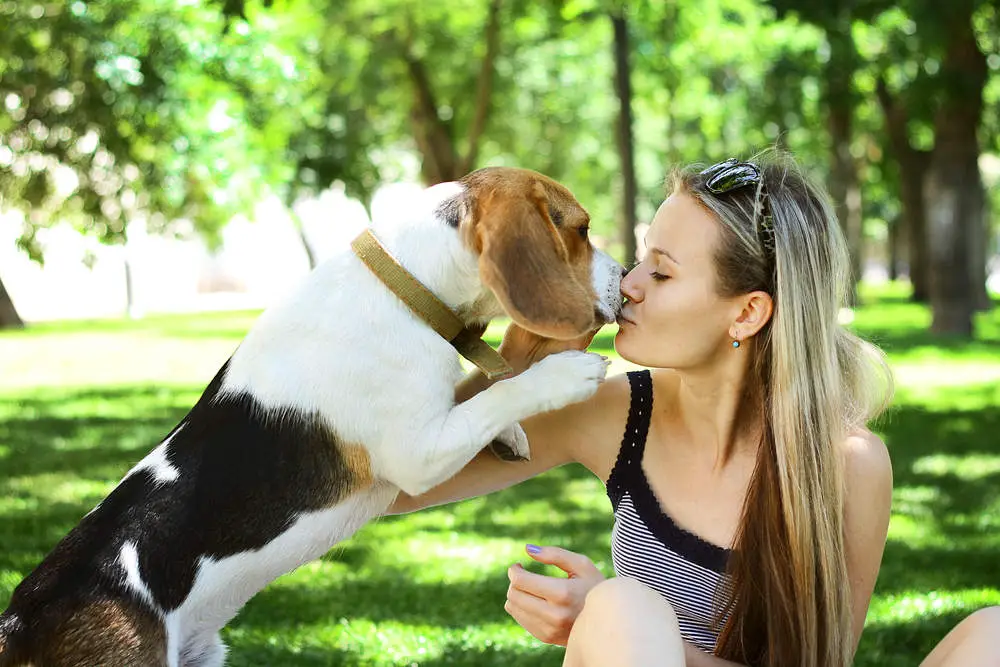
Small statured, compact and strong, beagles are gentle and fun-loving hounds that love long walks and plenty of time relaxing with their owners. These small dogs were originally bred as scent hounds to track and hunt small game like hare and rabbits. The beagles’ keen sense of smell makes them a popular choice for hunters and these pooches are often used as detection dogs looking for contraband at the borders.
Beagles are clever, curious and energetic by nature and need plenty of exercise and playtime. However, being hounds, beagles can be quite stubborn and need patient handling and creative training. Otherwise, they are generally low-maintenance dogs.
Beagle History
The origin of the ancient beagle breed is uncertain and has been the topic for debate. The origin of the name “beagle” is also not known. According to some experts, the name is derived from the Gaelic word “beag”, for “little”, while others are of the opinion that it comes from the French word “be’geule”, denoting the howls of the hounds while hunting.
According to the AKC, small pack hounds were used in England for rabbit and hare hunting long before 55 B.C., when the Roman legions arrived. There is another theory tracing the ancestors of beagles to ancient Greece. However, despite all the theories, it is accepted that beagles are direct descendants of the 1500s, English pack hounds.
The English gentlemen used similar small hounds to track and hunt hares and rabbits and since the prey was hunted on foot, beagles became a huge favorite amongst common trackers. It is reported that the English royalty was so intrigued by the breed, that it is said that Queen Elizabeth I kept pocket beagles that were just 9 inches in height and could fit in a pocket.
Related: Beagle vs Foxhound: Which Is Right For You?
In the 1800s, the breed was refined and standardized further in England and Scotland and resulted in the modern version of the beagle as seen today. Beagles made their first appearance in the United States after the Civil War when they were imported to the U.S. by American breeders and the breed became popular instantly. AKC recognized the breed in 1885 and today, the beagle is ranked the 7th most popular breed as per the AKC annual popularity list.
The most famous beagle is Snoopy from Charles Schulz’s comic strip, Peanuts. And it is reported that President Lyndon Johnson owned many beagles when he was in the White House.
Related: Beagle vs Basset Hound: What’s the Difference?
Appearance

Beagles are characterized by their broad head, long, wide and floppy ears, big brown or hazel colored eyes, black nose and a cute and completely adorable face. They have a tail that is high set but it does not curl over the pooch’s back.
This small to medium-sized hound breed comes in 2 varieties. The larger variety is around 13 to 15 inches in height and weighs around 20 to 35 lb, while the smaller variety is under 13 inches tall and weighs around 20 lb or less. Both the varieties are solid and sturdy.
Beagles are short statured with a small, compact body but have loads of power. They have a short and smooth double coat that comes in a variety of colors. However, the most common are tri-colors like tan, black and white or tan, white and blue. Other colors are red and white, tan and white, white and lemon and chocolate and white.
Beagles have thick coats that shed moderately all year round and they shed heavily in the spring. These hounds are fairly low maintenance and only need frequent brushing and upkeep of their general health.
Related: How Do I Know If My Beagle Is Purebred?
Temperament
Beagles are friendly, playful and active dogs with a curious nature. They are highly energetic and require a lot of exercise daily. However, when they have had their fill and are exhausted, they are quite content to hang around at home with their owners.
Beagles are sociable and cheerful dogs that love to play. They make excellent family pets and companions for kids. They get along well with other pets like dogs and cats. However, it is important to train and socialize your beagle from a young age. While they are not aggressive by nature, beagles can react to kids tugging their tails and ears. It is important to teach your kids to interact with your beagle and supervise them while they are playing with your pet.
They love the company and if left alone for too long, they may start howling and become destructive. They are friendly dogs and cannot be depended upon to guard your home. They may bark at an intruder, but won’t really do much other than wag their tail at them.
As scent hounds, beagles are quite obsessed with smells and eat everything they can find. So, it’s a good idea to beagle proof your kitchen, pantry, trash bins, cat’s litter box, clothes basket and wherever else he can eat from. Beagles are quite vocal and tend to bark and howl a lot.
Beagles are smart and intelligent dogs; however, they can be quite stubborn and do their own thing. You need a lot of patience to train your beagle, along with consistent training sessions with positive reinforcement. Once your dog is trained, your beagle will make a fine working dog.
Related: 23 of the Cutest Beagle Mix Breeds
Care

Beagles have short coats that are water resistant and shed moderately. Basic routine grooming is required to keep your pet looking and smelling his best. Thankfully the beagle’s coat does not accumulate a lot of dirt and debris, so they don’t need to be bathed frequently.
Brushing your beagle’s coat two to three times a week will prevent the dead hair from building up and also promote the growth of new and healthy hair. The double coat of the beagle sheds quite heavily during the spring months and you may have to increase the brushing to once every day.
Related: Do Beagles Have Dew Claws?
Be sure to keep your beagle’s floppy ears clean in order to prevent any ear infections because their long ears can hamper proper air circulations, which can cause infections. Also, check his nails and trim the nails regularly so that they don’t grow too long, which can affect your pet’s gait. Make sure to brush your pet’s teeth once or twice a week to maintain good oral hygiene.
Related: Can Beagles Get Bloat?
Exercise
Although beagles appear to act lazy, they have plenty of energy and need a lot of daily exercise to use up the energy. When your beagle is a puppy, he is still growing and requires a short walk and playtime sessions. This will prevent your pup from overexerting and putting too much pressure on his developing bones and joints.
Make sure that your beagle gets the right amount of exercise and plenty of stimulation to stay happy. Fully grown beagles require at least two hours of exercise every day. To make your pet’s walks and play more fun, let him run about and sniff around.
Related: Are Beagles Good Swimmers?
Playing scent-based games like asking your pooch to sniff a toy and hiding it for him to find is a good way to keep your beagle healthy and happy physically and mentally. However, you will require proper training and leash control to control your beagle if he gets interested in a scent that he wants to follow.
Related: How Fast Can Beagles Run?
Living Needs

Beagles, as you know, are scent hounds and love sniffing at everything around and usually have their nose close to the ground looking for the next scent to follow. The interesting thing about beagles is that they have around 220 million scent receptors, which makes them excellent at picking up smells as compared to the meager 5 million scent receptors in humans.
Since they get along very well with other dogs, running around in a dog park with other dogs can be a lot of fun for your pooch. Make sure that the yard in your home has a physical fence to prevent your beagle from digging under the fence or finding ways to escape.
While beagles are quite smart, they can be quite difficult to house train and it can even take up to one year to train your beagle. It is a good idea to practice crate training with your beagle pup, but the most important thing is to be patient, positive and consistent with his training. Beagles are very strong willed and stubborn and without obedience training, your pooch can become defiant and disobedient.
Beagles bay if they find an interesting scent and can become problem barkers because of separation anxiety or boredom. Beagles need the companionship of humans and other pets and are the happiest when they are with their owners who encourage their scent-tracking skills whether long walks or hikes, hunting or competitions.
Beagles are prone to becoming lonely and don’t do very well if left alone for very long. If not trained or exercised properly or left alone for long, your beagle can become too loud and destructive.
Related: Can Beagles Go Off-Leash?
Health
Generally, the beagle is a healthy breed and has a lifespan of up to around 10 to 15 years. However, even these dogs are prone to some health conditions and the most common ailments seen in beagles are:
Eye Disease
Beagles like other hound breeds suffer from the condition called cherry eye, where the eyes look bloodshot constantly. As they grow older, cataracts are also a common problem. Get your beagle checked by your vet often to detect early signs of eye disease so that you can prevent them.
Otitis
Beagles are susceptible to skin problems, usually inside the ear. Objects like parasites, infections, allergies or objects like grass seeds can irritate the ears and cause otitis or ear canal inflammation, which causes intense itching, causing your pet to flap its ears, shake its head and scratch them. If the cause of otitis is an allergy, then your pet will need treatment for it all his life.
Epilepsy
Beagles can suffer from epilepsy, a brain disorder causing seizures or fits. It can begin in dogs when they are as young as 6 months old. Epileptic seizures are generally not painful and depending on the severity of the condition, they can be controlled with medication ensuring that your beagle is normal, healthy and happy.
Thyroid Disease
Beagles often suffer from hypothyroidism, a condition that occurs when the thyroid gland does not secrete sufficient thyroid hormone. This causes slowing of the metabolic rate resulting in slow heart rate, weight gain and intolerance to the cold. The condition can be managed with thyroid hormone tablets, needed for the rest of your pet’s life.
Gastrointestinal Disorders
Beagles can suffer from gastrointestinal ailments such as gastroenteritis or a bowel obstruction because the dog has eaten string, stones or cloth, commonly resulting in diarrhea and/or vomiting. The treatment usually depends on the exact cause and results in full recovery.
MCT (Mast Cell Tumors)
The beagle dog breed is prone to the growth of cysts and tumors including MCTs (mast cell tumors). Mast cells are skin cells that release histamine and help the dog to respond in the case of trauma or damage. Sometimes, these mass cells can replicate and become a tumor known as MCT, which usually appears as a solid lump in the skin. The treatment of MCT depends on the location and size of the tumor; however, most often, it requires surgical removal.
Obesity
Beagles have a huge appetite and can eat anything, anytime. This makes the breed prone to obesity. It is very important that you measure each meal properly and control the in-between snacking and training treats. It is important to ensure that your beagle needs plenty of exercise and long walks to keep them physically and mentally fit.
Other ailments that can affect your beagle are issues such as dwarfism, hip dysplasia, etc. Make sure that you have your new beagle checked by the vet for any health issues when you bring him home.
Related: How to Tell If Your Beagle Is Pregnant
Described as “merry” by beagle lovers, these little pooches are very happy, loving and companionable dogs, which make them great companions for both adults, as well as kids. It’s no wonder that beagles are a huge favorite among American dog owners.
